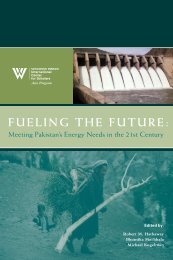Environmental Change and Security Project Report - Woodrow ...
Environmental Change and Security Project Report - Woodrow ...
Environmental Change and Security Project Report - Woodrow ...
Create successful ePaper yourself
Turn your PDF publications into a flip-book with our unique Google optimized e-Paper software.
unless the Central Asian states diversify their<br />
agricultural economies by turning away from<br />
water-intensive crops like cotton. To encourage<br />
this diversification, donors must push for political<br />
<strong>and</strong> economic reforms that would support<br />
family farms at the local level.<br />
Lastly, researchers <strong>and</strong> practitioners should<br />
assess whether they could use other environmental<br />
issues, besides water, to reduce interstate<br />
<strong>and</strong> intrastate conflicts. Water has overshadowed<br />
efforts to combat desertification <strong>and</strong> the<br />
loss of biodiversity in Central Asia. Peace parks<br />
along the border of Turkmenistan <strong>and</strong><br />
Uzbekistan, for example, might provide innovative<br />
opportunities for local communities to<br />
work together—both within states <strong>and</strong> across<br />
borders—to promote biodiversity, regional<br />
cooperation, <strong>and</strong> economic development.<br />
The Middle East: Peacekeeping<br />
Water cooperation in the Middle East—unlike<br />
Central Asia—has proved daunting because<br />
political problems dwarf the region’s environmental<br />
concerns. Conventional wisdom, which<br />
holds that larger political issues must be<br />
resolved for cooperation to emerge, exacerbates<br />
pessimism about the potential for environmental<br />
peacemaking in the region (see Lowi, 1993).<br />
Yet, once the hostile parties embark upon the<br />
road to peace, environmental issues could be<br />
used to sustain the journey. The Middle East<br />
could be a striking example of moving from<br />
environmental peacemaking to environmental<br />
peacekeeping. While the environment will not<br />
bring Israel <strong>and</strong> the Palestinian Authority to the<br />
bargaining table, it might provide one of the<br />
few opportunities to foster interdependence<br />
<strong>and</strong> hence sustain peaceful relations once the<br />
two parties agree to end the conflict.<br />
After Kuwait, the Gaza Strip is the most<br />
“water poor” region in the world, with only 52<br />
cubic meters available per person each year<br />
(International Atomic Energy Agency, 2003). It<br />
is also one of the most densely populated areas<br />
in the world: over 1.3 million Palestinians are<br />
crowded into approximately 400 square kilometers<br />
(U.S. Bureau of the Census, 2004). The<br />
Gaza Strip faces a mounting water crisis; water<br />
used in the Gaza Strip is not replenished, <strong>and</strong><br />
groundwater quality has severely deteriorated as<br />
saline water rapidly replaces fresh water.<br />
Resolving this crisis will require Israel’s cooperation,<br />
since the Gaza Strip shares the southern<br />
Mediterranean Coastal aquifer with its upstream<br />
neighbor. Although the poor water quality is<br />
caused by intrusions of natural saline groundwater,<br />
overuse in the Gaza Strip exacerbates the<br />
problem by lowering the water table <strong>and</strong> increasing<br />
the flow rate of natural saline water from<br />
Israel to the Gaza Strip (Vengosh et al., forthcoming).<br />
Even though its upstream consumption<br />
does not contribute to the aquifer’s deterioration,<br />
Israel could help mitigate salinity downstream<br />
by increasing pumping along the border<br />
region, which would reduce the flow of natural<br />
saline water, while the Palestinians simultaneously<br />
limit or reduce pumping within the Gaza Strip<br />
(Weinthal et al., in press). The international<br />
community should encourage Israel <strong>and</strong> the<br />
Palestinian Authority to develop a joint management<br />
plan to implement this solution. With<br />
international assistance, desalination plants<br />
along the Israeli-Gaza Strip border could treat<br />
the groundwater pumped by Israel <strong>and</strong> transport<br />
it to the Gaza Strip.<br />
This mutually beneficial plan would fortify<br />
relations, especially after political borders are<br />
established to separate the two parties. The<br />
Palestinian Authority would obtain another<br />
source of drinking water for its growing population<br />
<strong>and</strong> remediate the Gaza Strip’s salinity<br />
problem. For Israel, the groundwater transfer<br />
could serve as a goodwill gesture. While the<br />
upstream-downstream scenario <strong>and</strong> the region’s<br />
political tension would argue against cooperation,<br />
a joint water management plan to solve<br />
the Gaza Strip’s water crisis could instead help<br />
keep the peace after an Israeli withdrawal.<br />
Conclusion: Local <strong>Environmental</strong><br />
Peacemaking <strong>and</strong> International<br />
Peacekeeping<br />
<strong>Environmental</strong> peacemaking promises to transform<br />
our underst<strong>and</strong>ing of the link between the<br />
Israeli <strong>and</strong><br />
Palestinian water<br />
managers continued<br />
to cooperate—<br />
even as other forms<br />
of economic <strong>and</strong><br />
security cooperation<br />
collapsed—<br />
after the second<br />
intifada began in<br />
2000.<br />
21<br />
COMMENTARY • THE NEXT STEPS FOR ENVIRONMENT, POPULATION, AND SECURITY

















